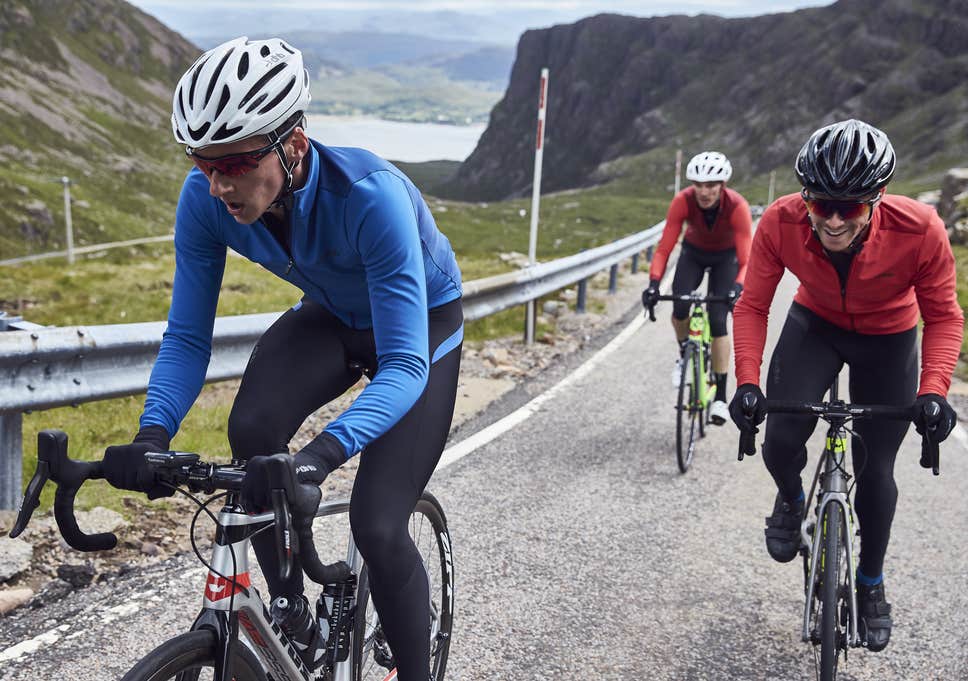In this post we look at how to become a stronger, injury free cyclist this winter and lay the foundations for better performance next season.

In the U.K it’s that time of year. The leaves are falling, the sun is losing its warmth and there are mince pies in the supermarket.
Seriously.
Winter is on its way and it’s a great time to assess your year and plan on making yourself a stronger cyclist for next season.
What is the ideal winter training programme for cyclists?
You probably understand you need to do something different during the off season. Just riding your bike at a lower volume and intensity, but with more cake stops won’t change much.
Cross training.
Switching to another endurance based activity is often mentioned as a viable off season option. Running, swimming, or perhaps a spot of mountain biking.
Certainly some of my fondest memories are thrashing around the Mendip hills on a mountain bike, covered in cow shit and laughing uncontrollably for most of it.
Good times.
Here’s the deal however, whilst these activities might help you maintain your aerobic fitness, they won’t provide a significantly different stimulus to your muscular system.
This is important if you want to be a stronger athlete next year.
Here’s why.
Endurance training may reduce the size of type 1 muscle fibres.
This effect of long term endurance training seems under reported and is perhaps counterintuitive.
Type 1 muscle fibres, also described as slow twitch fibres, are the engines of endurance exercise. It seems odd therefore that endurance training may reduce their size.
It’s been shown to do just that however.
This effect is mainly seen in seasoned endurance athletes and is likely related to an improvement in efficiency. In studies using sedentary individuals, the opposite effect is found.
It’s worth noting these changes are seen in muscles that are directly involved in the activity. It’s likely that upper body muscles will also atrophy in the pursuit of efficiency.
Endurance training can reduce muscle power and strength.
Along with a potential reduction in muscle fibre size, endurance exercise reduces the ability of muscle fibres to generate tension. And the speed at which they’re able to do so.
This effect has been shown in both type 1 and type 2a (fast twitch) muscle fibres.
Collectively these changes impact the strength of the muscle and it’s ability to produce power.
This is demonstrated in reduced anaerobic test performance, reduced vertical leap height and lower leg strength scores.
It’s reasonable to assume further endurance training will do little to restore these losses.
Niggles, aches and pains.
After a long season, you are likely to have areas of your body that bother you from time to time. A sore lower back for example, or a knee that aches every now and again.
Although switching up your activities may give troublesome muscles and joints a rest. It’s unlikely to improve them.
Moving around for long periods with a different method, is like switching from McDonalds to Burger King to improve your nutrition. It amounts to the same thing.
So given that further endurance training might not make you a stronger cyclist for next season…
What other types of training should you consider?
Scan most cycling magazines and websites and you’re guaranteed to see yoga, Pilates and core training mentioned.
Yoga and Pilates.
Whilst there may be benefits to both, look past the marketing to the adaptation that each activity is likely to stimulate.
In particular whether they can off set the deleterious effects that endurance exercise has on your muscular system.
To my knowledge there are no studies that show either Pilates or yoga will deliver consistent and significant strength gains.
The importance of core stability, one of the primary focuses of Pilates, has not been shown to be of great importance in any endurance sport so far. Using resistance bands for external resistance, as is common with the reformer, also has its disadvantages.
Whilst I’m sure it’s possible to gain some strength with yoga, the haphazard nature of the loading and the fact that you’re using your body weight for resistance, has inherent limitations.
The sight of Peter Sagan adding yoga to his gym routine will obviously have many endurance athletes wondering if this is his secret. Don’t be fooled however.
What makes Peter Sagan so good is the fact he’s Peter Sagan.
Resistance training.
The most significant change to endurance sport training over the last 10 years, has been the almost universal adoption of resistance training amongst elite level athletes.
It’s now become a fixture in the training programmes of long distance runners, triathletes and cyclists alike.
And for good reason.
Resistance training has consistently demonstrated its ability to increase the size of both type 1 and type 2a muscle fibres.
As we’ve discussed, this is critical in ameliorating some of the negative impact that endurance training can have on performance.
In this study a 10 week resistance training programme resulted in endurance trained cyclists improving their leg strength by an average of 30%.
Whilst the female duathletes in this study achieved a 45% increase in leg strength.
Resistance training has also been proven to improve Wingate test performance as well as power output.
It’s not just about improving your performance however. Resistance training will make you a more robust athlete and less prone to the overuse injuries that cyclists tend to suffer from.
This British Journal of Sports Medicine review found resistance training reduced the occurrence of overuse injuries by almost a half.
Summary.
Resistance training appears to provide the antidote to some of the potentially negative effects of long term endurance training. The off season is an ideal time to start using it.
Not only will it make you a stronger athlete for next season, it will also make you a healthier human being.